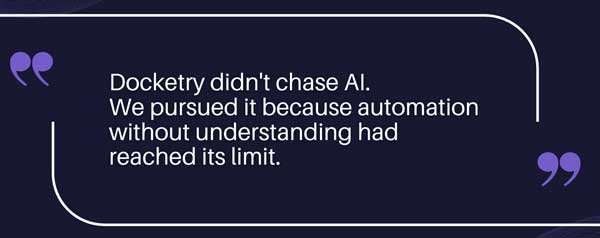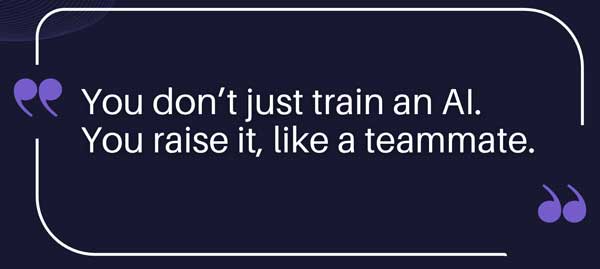From Concept to Reality: Journey with Agentic AI
Let me rewind the timeline to the early 2000s. We were knee-deep in automation, wrangling dashboards, and designing rule engines to process data faster than ever before. Nuvento was still focused on traditional enterprise automation, data pipelines, document extraction and workflow triggers. We were solving problems, yes, but not transforming how we worked.
We asked ourselves: What if the system could have anticipated the error situations? What if it could think? That was the spark. It wasn’t the shift towards AI because it was the trend, but because automation without cognition had hit a ceiling. It was time to build something that wouldn’t just execute but would understand.
Looking back now, that pivot was the beginning of what we now call Docketry, a system not of automation tools, but of agents. Systems with memory. With judgment. With voice.
From Scripts to Situational Intelligence
In the early days, our automations were reactive, detect, decide, and dispatch. They saved time, yes, but they couldn’t tell when context changed. A contract clause buried in a 70-page document could derail everything. That’s when we realized: the knowledge wasn’t missing, it was hidden.
That led to ExtractIQ, not as a standalone tool, but as a capability that gave our systems the power to read between the lines. It wasn’t just OCR. It was document intelligence that understood legal nuance, policy context, and exceptions humans often caught only after escalation.
But even that wasn’t enough.
We needed something more than automated responses; we needed agents that could pursue outcomes.
Engineering to Make Decisions
The move to agentic AI required us to engineer for judgment. We weren’t just mapping inputs to outputs. We were designing systems to weigh options, prioritize tasks, and act in real-time.
That’s where OpsIQ evolved, not as another bot, but as an operational layer that could simulate decision logic at scale. If a vendor ticket came in at 3 a.m., OpsIQ didn’t just classify it. It considered impact, urgency, historical resolution time, and rerouted before waking a human. It began asking the kind of questions a sharp ops lead would ask.
We weren’t replacing decision-makers. We were giving them a second brain.
Context: The Invisible Variable
We learned quickly that intelligence without memory is noise. Our earliest prototypes stumbled on one thing repeatedly: they didn’t remember. Without historical patterns, policy documents, or stakeholder nuance, they defaulted to static logic.
So we gave our system a memory.
ExtractIQ fed historical claims data into compliance agents. Audit agents used past behavior to predict anomalies. We trained them not just on workflows, but on organizational behavior.
When that clicked, everything else started aligning. Context wasn’t a feature. It was the foundation.
A System You Can Talk To (And Trust)
Even with memory and reasoning, something was missing. Humans didn’t trust decisions they couldn’t question.
So we built CASIE. But not as a chatbot. CASIE can become the voice of your system, a conversational agent that could explain itself. Why was that request delayed? Why was the workflow paused?
CASIE didn’t just respond, she reasoned. She translated machine logic into business context.
That builds trust. And trust, in enterprise AI, is the real game-changer.
How the Agents Work
The real proof came during a high-stakes compliance review. One of our agents flagged an anomaly, not because it violated a rule, but because the clause pattern looked different from historical deals. It rerouted the ticket, looped in a reviewer, and paused the payout.
No one had written that rule.
The system had learned what normal looked like and acted when something didn’t fit.
We weren’t chasing automation anymore. We were building judgment into the core.
We’ve seen similar moments for OpsIQ and Casie also.
What We Got Wrong (So You Don’t Have To)
Of course, we stumbled. Our first agentic prototypes were too rigid. Too much logic. Too little learning. We assumed humans would stop overriding. They didn’t.
So we stopped fighting that. We let agents observe override patterns. Adjust to them. Learn from them.
And like any teammate, it had to learn by being in the room. By making mistakes. By asking questions.
The Inevitable Leadership Shift
This journey didn’t just change our systems. It changed how we lead.
As a CEO, I stopped asking, “What can this tool do?” and started asking, “What kind of teammate do I need this AI to be?”
Because when you are dealing with big enterprises, the issue isn’t workload, it’s the fatigue that comes with continuous decision making. The 2 a.m. alerts. The 50-tab dashboards. The judgment calls when you’re out of context.
Agentic AI doesn’t eliminate work. It ensures you’re not spending your best minds on the wrong problems. That’s the only sustainable way to scale without burning out your top teams.
Where We’re Headed Next
This isn’t about building better bots. It’s about building digital operators, systems that reflect business intent, not just IT design.
Docketry is not an ordinary AI toolset. It’s a living system that thinks alongside our people. And it keeps evolving.
So if you’re still optimizing for tasks, it’s time to rethink the model. Because the real leverage in the enterprise is not speed.
It’s judgment.
And if you want to scale judgment, not just actions, you need to give your enterprise a brain.
That’s the journey we’ve been on. And it’s only just begun.







